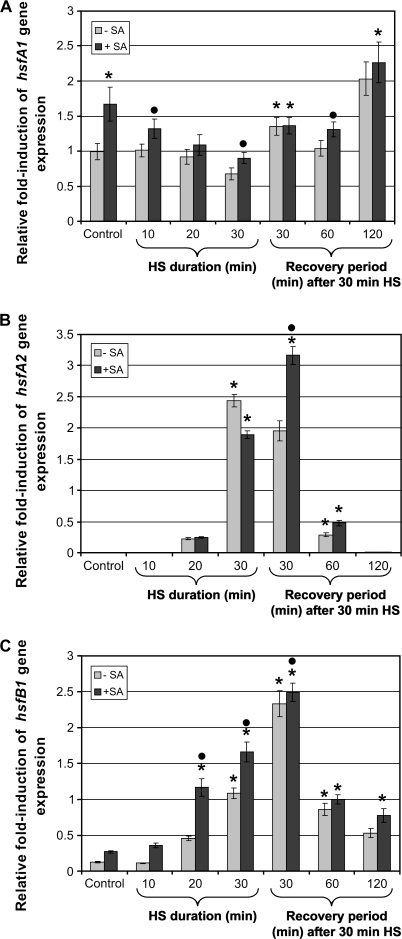Fig. 4.
Expression levels of hsfA1, hsfA2, and hsfB1 in tomato seedlings. Real-time PCR analysis of RNA isolated from tomato seedlings maintained at room temperature (Control, –SA) or treated with SA (0.1 mM) (Control, +SA), or heat shocked (40 °C, 30 min) in the presence (+SA) or absence (–SA) of SA. RNA was isolated after heat shock (HS; 10, 20, and 30 min, no recovery period), or after 30 min HS followed by a 30, 60, or 120 min recovery period. (A) SA on its own was able to enhance hsfA1 gene expression on its own. In heat-treated seedlings, the presence of SA was able to potentiate hsfA1 gene expression at all time intervals except after the 30 min recovery period. (B) The heat-inducible hsfA2 remained unaffected under control conditions (Control, –SA and +SA). In the absence of SA, maximum induction of hsfA2 expression was observed after 30 min HS (no recovery period). During the recovery period, hsfA2 gene expression started to decline and no expression was observed after a 120 min recovery period. The presence of SA caused a significant potentiation of hsfA2 in heat-treated seedlings after the 30 min recovery period. (C) In heat-treated seedlings (no SA), hsfB1 showed increased gene expression at early intervals followed by a sharp decline during the 60 min and 120 min recovery period. The presence of SA was able to potentiate the expression of hsfB1 in control and heat-treated seedlings when compared with the respective controls (–SA). Bars represent average values (n=7) and error bars indicate SEM. Symbols indicate significant differences (least significant difference) at P <0.001: * indicates a difference between each treated sample (SA and/or HS) and the non-treated control (Control, –SA); the filled circles indicates a difference between the SA-treated sample versus the non-SA-treated sample at that specific time point (HS±recovery period).

